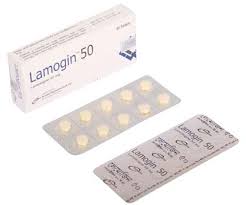lamogin
Introduction to Lamogin
Lamogin is a medication primarily used to treat epilepsy and bipolar disorder. It helps in controlling seizures and stabilizing mood swings, making it a vital part of treatment for these conditions.
Composition of Lamogin
Lamogin contains the active ingredient Lamotrigine, which works by stabilizing electrical activity in the brain. It inhibits certain voltage-gated sodium channels, reducing the release of excitatory neurotransmitters like glutamate.
Uses of Lamogin
- Treatment of epilepsy, particularly partial and generalized tonic-clonic seizures.
- Management of bipolar disorder to prevent depressive episodes and stabilize mood.
- Off-label uses may include treatment for borderline personality disorder and neuropathic pain.
Side Effects of Lamogin
Common Side Effects:
- Dizziness
- Headache
- Nausea
- Insomnia
Serious Side Effects:
- Severe skin rash, potentially leading to life-threatening conditions like Stevens-Johnson syndrome.
- Liver problems
- Blood disorders
- Increased risk of suicidal thoughts or behavior
Precautions of Lamogin
Lamogin should be used with caution in individuals with liver or kidney problems. Gradual dose adjustments are necessary to reduce the risk of severe skin reactions. If a rash develops, the medication should be discontinued immediately. It's also important to monitor for signs of suicidal thoughts.
How to Take Lamogin
- Start with a low dose, typically 25 mg once daily for the first 2 weeks.
- Gradually increase the dose to 50 mg, then 100 mg, and up to 200 mg per day as directed by your healthcare provider.
- Take Lamogin with or without food.
- Swallow the tablet whole with water.
Conclusion of Lamogin
Lamogin is an effective medication for managing epilepsy and bipolar disorder. By stabilizing electrical activity in the brain, it helps control seizures and mood swings. However, it is important to follow your healthcare provider's instructions and be aware of potential side effects and precautions.
Similar Medicines
Available in 3 variations

Lamogin 100mg Tablet DT 10s
strip of 10 tablet dt

Lamogin 50mg Tablet DT 10s
strip of 10 tablet dt

Lamogin 25mg Tablet
Lamogin 25mg Tablet
strip of 10 tablets
Related Faqs

I started Lamictal and developed a rash. The doctor stopped Lamictal immediately and prescribed another medicine. Why?
In some cases patients have experienced significant skin rashes and subsequently required hospitalization within just 8 weeks of initiating treatment with Lamictal These rashes can progress to severe skin infections posing a potential threat to the patients life As a precautionary measure it is strongly recommended that if a patient develops any type of rash after commencing Lamictal the medication should be discontinued immediately and not resumed This advice applies even to cases where the rashes appear to be mild or nonserious Consequently your doctor made the decision to switch your medication to ensure your safety and minimize any potential risks associated with taking Lamictal

How to take Lamictal?
Lamictal an anticonvulsant medication is suitable for consumption with or without food Adhering to the doctors recommended dosage and duration is crucial for reaping the full advantages of Lamictal Whether taken with a meal or on an empty stomach Lamictal remains effective in its intended purpose Therefore individuals can choose to ingest it with or without food depending on their personal preference or convenience It is essential however to follow the prescribed dosage and duration of the medication as advised by the healthcare professional By maintaining this regimen patients can ensure they receive the maximum benefits from using Lamictal Consequently it is vital to consult with a healthcare provider for proper instruction on how to take Lamictal and to address any concerns or questions about the medication Following the recommended guidelines will contribute to the safe and effective use of Lamictal and optimize its positive effects

I started Lambi and developed a rash. The doctor stopped Lambi immediately and prescribed another medicine. Why?
There have been documented cases in which individuals experienced the onset of severe rashes within a timeframe of 8 weeks after commencing treatment with Lambi resulting in the necessity of hospitalization In certain instances these rashes progressed into severe skin infections posing a potential threat to the patients life With this in mind it is strongly recommended that if a patient begins to develop rashes subsequent to initiating Lambi treatment the medication should be promptly discontinued and not resumed This precaution is applicable even in cases where the rashes appear to be mild and not of a serious nature It is due to these concerns that your physician made the decision to switch your medication

I started Lamizine and developed a rash. The doctor stopped Lamizine immediately and prescribed another medicine. Why?
There have been several documented cases in which patients have experienced the onset of severe rashes within a period of 8 weeks after initiating Lamizine treatment leading them to require hospitalization In some instances these rashes have escalated into lifethreatening skin infections posing a significant risk to the patients wellbeing Consequently it is strongly recommended that if a patient presents with the emergence of rashes subsequent to commencing Lamizine therapy the medication should be immediately discontinued and must not be reintroduced Even if the rashes are mild or seemingly insignificant the use of Lamizine should be halted as a precautionary measure It is due to this critical concern that your doctor has decided to switch your medication in order to prioritize your safety and wellbeing

I started Lamocent and developed a rash. The doctor stopped Lamocent immediately and prescribed another medicine. Why?
There have been numerous cases reported where patients experienced the emergence of severe rashes within a span of 8 weeks after commencing their Lamocent medication which subsequently led to hospitalization In some instances these rashes progressed into grave skin infections posing lifethreatening risks to the patients Consequently it is strongly recommended that if any patient encounters rashes subsequent to initiating Lamocent the usage of the medication should be immediately ceased and not resumed under any circumstances Even if the rashes appear to be mild and not deemed serious it remains crucial to halt the administration of Lamocent In fact it is due to this specific reason that your doctor opted to switch your medication

I started Lamigine and developed a rash. The doctor stopped Lamigine immediately and prescribed another medicine. Why?
There have been cases reported in which individuals have experienced the onset of severe rashes within a span of 8 weeks after initiating treatment with Lamigine leading to their hospitalization In some instances these rashes have progressed into severe skin infections putting the patients life at risk Consequently it is strongly recommended that if a patient develops any type of rash subsequent to starting Lamigine the medication should be immediately discontinued and not resumed thereafter Even if the rashes appear mild or nonserious the use of Lamigine is halted which is precisely why your doctor made the decision to switch your medication This precautionary measure is crucial in order to safeguard your health and prevent any potential lifethreatening complications associated with these rashes
Related Posts

1:15
How Do You Know If You Have a Vaginal Infection? Warning Signs!

1:15
Top Health Benefits of Cinnamon | How to Use It for Better Health!

1:15
Is Your Blood Pressure Too Low? What Are the Best Remedies to Fix Low Blood Pressure Instantly?

1:15
Mala D: How it works, When and How to take Mala D and Side Effects of Mala D!

1:15
Reduce Inflammation Naturally: Best Foods for Heart, Diabetes & Overall Health!


















.svg)
